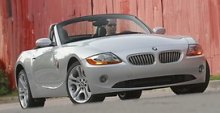 BMW’s
Z-line roadster started life in 1988 by the experimental Z1. In 1996,
the
mass production Z3 rolled off its sole production line in Spartanburg,
USA. Unfortunately, this started an era some BMW fans would rather
forget.
The Z3 was a low-cost project. To save money, it employed a pair of
trailing-arm
suspensions from an old 3-series whose production was already phased
out
for 6 years when Z3 was launched. It was the first BMW built in the USA
to take advantage of lower manufacturing cost, and unfortunately, the
early
production was criticized for lack of German quality. More unfortunate
is that it was the first BMW styled by the controversial Chris Bangle.
Its retro shape did not win many respect from the design world. BMW’s
Z-line roadster started life in 1988 by the experimental Z1. In 1996,
the
mass production Z3 rolled off its sole production line in Spartanburg,
USA. Unfortunately, this started an era some BMW fans would rather
forget.
The Z3 was a low-cost project. To save money, it employed a pair of
trailing-arm
suspensions from an old 3-series whose production was already phased
out
for 6 years when Z3 was launched. It was the first BMW built in the USA
to take advantage of lower manufacturing cost, and unfortunately, the
early
production was criticized for lack of German quality. More unfortunate
is that it was the first BMW styled by the controversial Chris Bangle.
Its retro shape did not win many respect from the design world.Fast forward to year 2002, Chris Bangle becomes chief of BMW design and his power rises to the peak in the Z4. My God, from photographs the Z4 looks really odd, disgusting and terrible. I nearly thought Bangle might have received money from Mercedes-Benz to ruin BMW... of course not. He seemed really a keen believer to the so-called "flame-surface" styling theme. In September, when I saw the real car in a motor show, it did change my view... a bit. I have to admit the more you look the less odd and less disgusting it is. Sure, it is by no means a beautiful car, it lacks a proper proportion characterizing all good sports car designs, but it is undoubtedly full of character. Like a Fiat Multipla, it is ugly yet interesting. 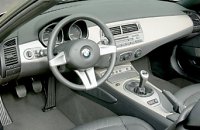 The
interior looks better. The alloy-looking plastic dashboard and the
compact
twin-dial instrument reading follows the philosophy of "simple is
beautiful".
Nevertheless, I still prefer the traditional driver-focused center
console.
In terms of function, the cabin is hard to criticize. There is
sufficient
room for 2 people (Z4 is a strict 2-seater). The soft-roof is fully
electric-operated
and wind management is good. The
interior looks better. The alloy-looking plastic dashboard and the
compact
twin-dial instrument reading follows the philosophy of "simple is
beautiful".
Nevertheless, I still prefer the traditional driver-focused center
console.
In terms of function, the cabin is hard to criticize. There is
sufficient
room for 2 people (Z4 is a strict 2-seater). The soft-roof is fully
electric-operated
and wind management is good.The mechanical side shows no technological breakthrough, but at least it is a properly engineered BMW, unlike its predecessor. Predictably, all the most expensive components are shared with the 3 series, these include the 6-cylinder engine family, the front MacPherson struts and rear Z-axle suspensions. A new 6-speed manual gearbox, however, was never used in the 3-series. The steel monocoque has doubled torsion stiffness from the Z3, this allow a firmer setup of suspensions for the benefit of body control yet improve refinement. During hard cornering or running on bumpy surfaces, the new chassis no longer creaks like the old one. Nor there is any body flexing. The new electrical-assisted steering doesn’t transmit vibration or kickback to the driver. Unfond memory from the Z3 era is washed way. 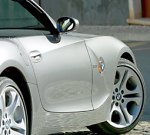 Predictably,
the powertrain is wonderful. We have praised the 231hp 3.0-litre and
192hp
2.5-litre inline-6 (both with Bi-Vanos) many times. They are smooth,
rev-happy
and especially torquey from very low rev. The new 6-speed manual also
live
up to our expectation for BMW’s gearboxes. The shift is slick and
precise. Predictably,
the powertrain is wonderful. We have praised the 231hp 3.0-litre and
192hp
2.5-litre inline-6 (both with Bi-Vanos) many times. They are smooth,
rev-happy
and especially torquey from very low rev. The new 6-speed manual also
live
up to our expectation for BMW’s gearboxes. The shift is slick and
precise.With the 231hp engine, Z4 3.0 can easily out perform a 2.7-litre Porsche Boxster. BMW claims 0-60mph can be done in 5.6 seconds, against Boxster’s 6.3 seconds. Its 1290kg kerb weight undercuts a 330i by 220kg while nearly matches the Boxster and Honda S2000. On the other hand, its 221 lbft of maximum torque, with 90% of that from 1500 to 6000rpm, is a decisive factor for its superior performance. While I mention Boxster more and more, I must point out that the Z4 has re-positioned itself to the same market segment as the base Boxster and Mercedes SLK, unlike Z3 which had 4-cylinder models which targeted at Mazda MX-5. This makes better use of the brand image to raise profit margin. 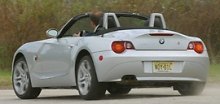 Unfortunately,
that means the Z4 will inevitably be compared with the mighty Boxster.
Faces a SLK, it’s fine. Faces a Boxster, there is no chance.
Undoubtedly,
BMW has some ingenious engineers to make their cars almost as fun as
Porsche,
but unfortunately those engineers were not involved in the Z4 projects
- or were they forced to engineer a less driver-focused roadster?
despite
of the shortened wheelbase and the lighter kerb weight, the Z4 is not
fun
to drive. Basically, it is tuned to be an inherent understeerer. Always
understeer, understeer and understeer. Whenever you push it harder and
faster, understeer will get into the picture. The harder it corners,
the
more understeer it shows. Now we don’t know why BMW needs
rear-wheel-drive
and an engine locating behind the front axle to create an understeerer.
Another problem is the new electric power steering whose feel fades
away
as speed increases. Sadly, a sports car without steering feel will
never
be a great sports car, nor a great BMW. Really,
I cannot recall any previous BMWs were criticized as lack of steering
feel. Unfortunately,
that means the Z4 will inevitably be compared with the mighty Boxster.
Faces a SLK, it’s fine. Faces a Boxster, there is no chance.
Undoubtedly,
BMW has some ingenious engineers to make their cars almost as fun as
Porsche,
but unfortunately those engineers were not involved in the Z4 projects
- or were they forced to engineer a less driver-focused roadster?
despite
of the shortened wheelbase and the lighter kerb weight, the Z4 is not
fun
to drive. Basically, it is tuned to be an inherent understeerer. Always
understeer, understeer and understeer. Whenever you push it harder and
faster, understeer will get into the picture. The harder it corners,
the
more understeer it shows. Now we don’t know why BMW needs
rear-wheel-drive
and an engine locating behind the front axle to create an understeerer.
Another problem is the new electric power steering whose feel fades
away
as speed increases. Sadly, a sports car without steering feel will
never
be a great sports car, nor a great BMW. Really,
I cannot recall any previous BMWs were criticized as lack of steering
feel.No, Z4 is not as flawed as Z3 when it was launched. Its overall driving impression is better than SLK and Audi TT - admittedly, both are very old now. Its problem is the change of heart - maybe to please the American buyers, it is tuned to be easy to drive thus loses driver appeal that the M3 or even a 330Ci has. For an all-new roadster, especially for a BMW, this is hardly forgivable. |
| The above report was last updated on 5 Dec 2002. All Rights Reserved. |
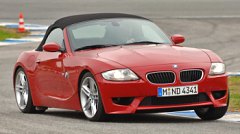 Having
seen Z3 M Roadster, the arrival of Z4 M Roadster is by no means a
surprise. The only question is why it took more than 3 years to
realize. In my opinion, the fact that this car arrived just after the
previous M3 ceased production is not just coincidence. We all know the
production capacity of M GmbH, the division which hand-builds all the M
motors, is quite limited. As the next generation M3 will switch to V8,
the production line of the previous 3.2-litre M-power straight-6 is
freed up. Now it could be used to serve the new M Roadster.
Having
seen Z3 M Roadster, the arrival of Z4 M Roadster is by no means a
surprise. The only question is why it took more than 3 years to
realize. In my opinion, the fact that this car arrived just after the
previous M3 ceased production is not just coincidence. We all know the
production capacity of M GmbH, the division which hand-builds all the M
motors, is quite limited. As the next generation M3 will switch to V8,
the production line of the previous 3.2-litre M-power straight-6 is
freed up. Now it could be used to serve the new M Roadster.  On the
road, the M Roadster bridges between the crude TVR and the polished
Porsche. Compare with Porsche Cayman S and Boxster S, its power
delivery is more thrilling yet more elastic. Its performance is simply
astonishing. If we judge cars only by engine and performance, it would
have come first.
On the
road, the M Roadster bridges between the crude TVR and the polished
Porsche. Compare with Porsche Cayman S and Boxster S, its power
delivery is more thrilling yet more elastic. Its performance is simply
astonishing. If we judge cars only by engine and performance, it would
have come first. 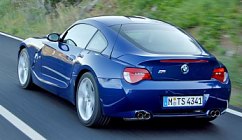 Two
things mark the Coupe out of Z4 Roadster. The first one is design. If
you like the strange look of Z4 Roadster (it has plenty of admirers,
unbelievably), you may prefer the Z4 Coupe even more. At first, you
may find its proportion totally wrong – the engine compartment is way
too long, the cockpit locates at the wrong side, the bubble roof
intrudes into the body, the tail too short and too much higher than the
shoulder line… nevertheless, strange designs seemed fashionable these
days, and Chris Bangle's careful treatment to surfaces and details
means it is by no means a half-hearted design, but a brave and unusual
design. Love it or not, you can't deny that the Z4 Coupe is a very
special car, even more so than the Roadster.
Two
things mark the Coupe out of Z4 Roadster. The first one is design. If
you like the strange look of Z4 Roadster (it has plenty of admirers,
unbelievably), you may prefer the Z4 Coupe even more. At first, you
may find its proportion totally wrong – the engine compartment is way
too long, the cockpit locates at the wrong side, the bubble roof
intrudes into the body, the tail too short and too much higher than the
shoulder line… nevertheless, strange designs seemed fashionable these
days, and Chris Bangle's careful treatment to surfaces and details
means it is by no means a half-hearted design, but a brave and unusual
design. Love it or not, you can't deny that the Z4 Coupe is a very
special car, even more so than the Roadster. Another
thing mark the Z4 Coupe out is chassis rigidity. While the
Roadster has a torsional stiffness at 16,000 Nm per degree, the Coupe
is doubled to 32,000 Nm / degree, all contributed by the fixed metal
roof. This strengthen my believe that no hardcore drivers should
purchase a convertible unless it has a carbon fiber tub. Just like the
conversion from Porsche Boxster to Cayman, the roof converted the
handling character of Z4 Coupe massively. This is especially apparent
in the fastest version, M Coupe.
Another
thing mark the Z4 Coupe out is chassis rigidity. While the
Roadster has a torsional stiffness at 16,000 Nm per degree, the Coupe
is doubled to 32,000 Nm / degree, all contributed by the fixed metal
roof. This strengthen my believe that no hardcore drivers should
purchase a convertible unless it has a carbon fiber tub. Just like the
conversion from Porsche Boxster to Cayman, the roof converted the
handling character of Z4 Coupe massively. This is especially apparent
in the fastest version, M Coupe. 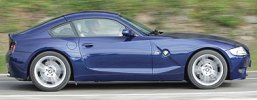 Like the
M Roadster, the M Coupe is powered by the previous M3's
3246cc, fast-revving straight-6 pumping out 343 horsepower. The
marvelous engine mates with 6-speed manual gearbox and Variable
M-differential. In the Coupe, the M-differential has a more aggressive
setting than the M Roadster, allowing more wheel slip hence more fun.
Moreover, the Coupe also gets quicker steering, stiffer springs
and retuned dampers. All these aggressive setting can be adopted
because there is no worry of abusing the much strengthened chassis.
Like the
M Roadster, the M Coupe is powered by the previous M3's
3246cc, fast-revving straight-6 pumping out 343 horsepower. The
marvelous engine mates with 6-speed manual gearbox and Variable
M-differential. In the Coupe, the M-differential has a more aggressive
setting than the M Roadster, allowing more wheel slip hence more fun.
Moreover, the Coupe also gets quicker steering, stiffer springs
and retuned dampers. All these aggressive setting can be adopted
because there is no worry of abusing the much strengthened chassis.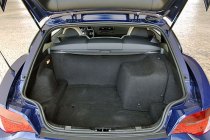 On the
road, the M Coupe displays much better handling than the Roadster. It
has great balance, sharp turn-in and rock steady body control. In
addition to the addictive revving and sounding M-power straight-6, the
quick gearshift and lightning performance
(0-60 mph in 4.8 seconds), it is a great fun to drive.
On the
road, the M Coupe displays much better handling than the Roadster. It
has great balance, sharp turn-in and rock steady body control. In
addition to the addictive revving and sounding M-power straight-6, the
quick gearshift and lightning performance
(0-60 mph in 4.8 seconds), it is a great fun to drive.